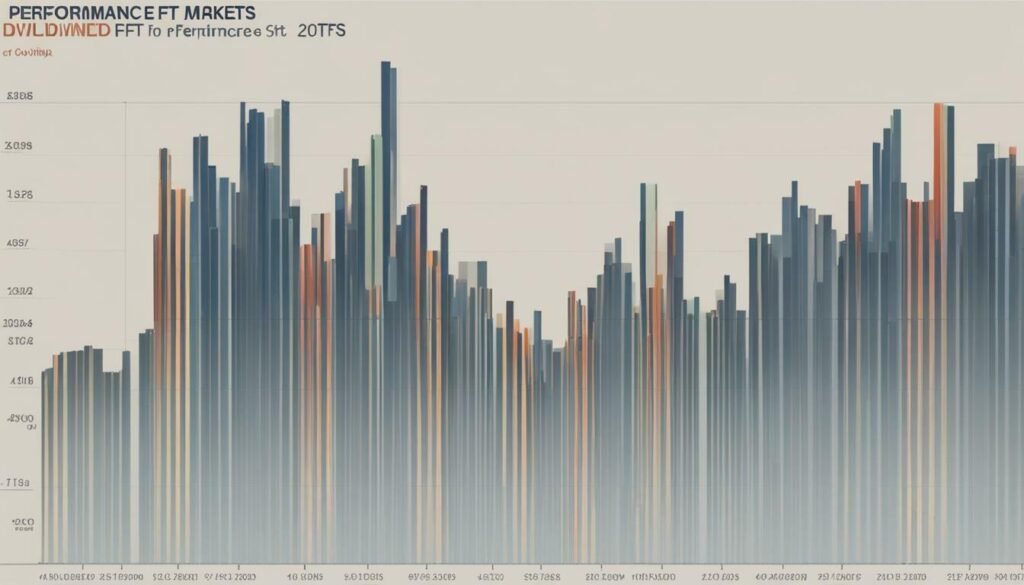7 Powerful Steps to Achieve a Balanced Portfolio with Dividend ETFs
Building a balanced portfolio requires careful consideration of investment strategies, and one effective approach is to include dividend ETFs in your portfolio mix. Dividend ETFs are exchange-traded funds that invest in a portfolio of dividend-paying stocks. They are designed as an income-investing strategy for individuals seeking regular income from their investments. Dividend ETFs are passively managed and track specific indexes that include companies with a strong history of dividend increases and lower risk. These ETFs offer diversification, broad market exposure, and low costs. They are recommended for risk-averse investors seeking income.
Dividend ETFs can help improve portfolio returns and reduce risk, as dividend-paying stocks have historically delivered attractive risk-adjusted returns and have tended to perform better in down markets. They also provide a steady source of income and may be a quality option for investors seeking income with less risk compared to non-dividend paying stocks. Investors can access dividend ETFs through their brokers or online brokerage services. Some popular dividend ETFs include Vanguard Dividend Appreciation ETF, Fidelity International High Dividend ETF, and iShares Core High Dividend ETF.
Key Takeaways:
- Dividend ETFs are exchange-traded funds that invest in dividend-paying stocks, offering regular income to investors.
- These ETFs provide diversification, broad market exposure, and low costs.
- Dividend-paying stocks historically deliver attractive risk-adjusted returns and perform better in down markets.
- They offer a steady source of income with less risk compared to non-dividend paying stocks.
- Popular dividend ETFs include Vanguard Dividend Appreciation ETF, Fidelity International High Dividend ETF, and iShares Core High Dividend ETF.
Understanding Dividend ETFs for Portfolio Diversification
Dividend ETFs are exchange-traded funds that offer investors a way to diversify their portfolios by investing in a range of dividend-paying stocks across different sectors. These ETFs are designed as a long-term investment strategy with the aim of providing a steady stream of income for investors. By including dividend ETFs in their portfolios, investors can benefit from the potential for capital appreciation while also earning regular dividend payments.
One of the key advantages of dividend ETFs is their ability to provide portfolio diversification. These funds typically invest in a broad range of companies, spanning different industries and sectors. This diversification helps reduce the risk associated with investing in a single stock or sector, as the performance of one company or industry is less likely to have a significant impact on the overall portfolio.
In addition to diversification, dividend ETFs offer investors exposure to high-quality dividend-paying stocks. These stocks are selected based on their track record of consistently increasing dividend payments and their lower risk profile. By investing in these stocks through ETFs, investors can gain exposure to a portfolio of companies with a strong history of generating steady cash flows and distributing profits to shareholders in the form of dividends.
Investing in dividend ETFs also aligns with the principles of long-term investing. These funds are designe to be held for an extended period, allowing investors to benefit from the power of compounding or snowballing. Over time, reinvesting dividends can significantly enhance investment returns, potentially accelerating the growth of the portfolio. This long-term approach to investing is particularly suited for individuals with a low tolerance for risk who seek stable income and steady capital appreciation.

Diversification for a Balanced Portfolio with Dividend ETFs
When constructing a diversified portfolio, asset allocation is a critical consideration. Dividend ETFs can play a valuable role in this process by providing exposure to a wide range of dividend-paying stocks. This asset class can help balance the portfolio, reducing volatility and potentially enhancing performance. By incorporating dividend ETFs into a diversified investment strategy, investors can take advantage of the benefits of dividend income while mitigating risk.
| Dividend ETF | Expense Ratio |
|---|---|
| Vanguard Dividend Appreciation ETF | 0.06% |
| Fidelity International High Dividend ETF | 0.39% |
| iShares Core High Dividend ETF | 0.08% |
“Investing in dividend ETFs offers the potential for regular income, diversification, and long-term growth, all at relatively low costs.” – Dr Lincoln C. Wood
In conclusion, dividend ETFs provide a unique opportunity for investors to diversify their portfolios, generate regular income, and benefit from the potential for long-term growth. By investing in a diversified portfolio of dividend-paying stocks through ETFs, investors can potentially enhance their overall investment returns while managing risk. As with any investment strategy, it is essential for investors to conduct thorough research and consider their individual financial goals and risk tolerance before making any investment decisions.
The Benefits of Dividend ETFs for Income Growth
Dividend ETFs can provide a reliable and growing source of income, making them an attractive option for investors seeking passive investment strategies and tax-efficient income growth. These exchange-traded funds offer exposure to a diversified portfolio of dividend-paying stocks, allowing investors to benefit from the potential for regular cash distributions while minimizing the need for active stock selection.
One of the key advantages of dividend ETFs is the ability to generate income from a broad range of companies across different sectors and regions. By investing in a dividend ETF, investors gain access to a diversified portfolio that can help smooth out the volatility associated with individual stock holdings. This diversification helps mitigate risk and provides a more consistent income stream, which is particularly important for those relying on their investments to supplement their income or meet their retirement needs.
Furthermore, dividend ETFs are often favored for their potential tax efficiency. The dividend income generated from these funds can be taxed at a lower rate compared to other forms of investment income, such as interest or capital gains. This tax advantage can help investors maximize their after-tax returns and potentially increase their overall income growth over time.

| Dividend ETF | Expense Ratio | Dividend Yield | Market Capitalization |
|---|---|---|---|
| Vanguard Dividend Appreciation ETF | 0.08% | 1.7% | Large Cap |
| Fidelity International High Dividend ETF | 0.39% | 3.1% | Global |
| iShares Core High Dividend ETF | 0.08% | 4.0% | Large Cap |
In conclusion, dividend ETFs offer an attractive option for investors seeking reliable income and tax-efficient growth. These funds provide exposure to a diversified portfolio of dividend-paying stocks, allowing investors to benefit from consistent income generation and potential capital appreciation. As always, it is important for investors to conduct thorough research and consider their investment objectives and risk tolerance before making any investment decisions. However, for those looking to enhance their income growth while maintaining a passive investment strategy, dividend ETFs can be a valuable addition to their portfolio.
The Performance of Dividend ETFs in Challenging Markets
When markets face uncertainty and volatility, dividend-paying stocks have shown a tendency to outperform non-dividend paying stocks, making dividend ETFs an effective tool for managing risk in investment portfolios. Dividend ETFs provide investors with exposure to a diversified portfolio of dividend-paying stocks, offering the potential for stable income and attractive risk-adjusted returns.
Historical data has consistently shown that dividend-paying stocks have been more resilient during market downturns compared to their non-dividend paying counterparts. This resilience can be attributed to the underlying companies’ ability to generate consistent cash flows and maintain dividend payments even in challenging economic environments.
According to a study conducted by BlackRock, dividend-paying stocks outperformed non-dividend paying stocks by an average of 1.75% per year from 1990 to 2020. This outperformance was even more pronounced during periods of market stress, with dividend-paying stocks delivering significantly higher returns and lower volatility. Dividend ETFs, which consist of a basket of these dividend-paying stocks, can help investors weather market volatility and potentially achieve higher risk-adjusted returns.
The Benefits of Dividend ETFs in Challenging Markets
Dividend ETFs offer several benefits in challenging markets. Firstly, they provide investors with exposure to a diversified portfolio of dividend-paying stocks, reducing the impact of individual stock volatility. This diversification helps to mitigate risk and smooth out returns.
| Benefits of Dividend ETFs in Challenging Markets |
|---|
| 1. Diversification: Dividend ETFs offer exposure to a broad range of dividend-paying stocks, reducing the concentration risk associated with individual securities. |
| 2. Income Generation: Dividend ETFs provide a steady stream of income through regular dividend payments from the underlying stocks. |
| 3. Risk Mitigation: Dividend-paying stocks have historically exhibited lower volatility and higher risk-adjusted returns compared to non-dividend paying stocks, making dividend ETFs an effective risk management tool. |
| 4. Potential for Capital Appreciation: In addition to income generation, dividend ETFs offer the potential for capital appreciation as the underlying stocks increase in value over time. |
Investors looking to navigate challenging markets should consider including dividend ETFs in their investment strategy. These ETFs can help investors achieve a balance between income generation and risk mitigation, making them a valuable component of a well-diversified portfolio.

Conclusion
Incorporating dividend ETFs into a balanced portfolio can contribute to portfolio diversification, provide a reliable source of income, and enhance long-term investment strategies for financial stability and growth.
Dividend ETFs are exchange-traded funds that invest in a portfolio of dividend-paying stocks. These ETFs are designed for individuals seeking regular income from their investments and are passively managed to track specific indexes. By investing in dividend ETFs, investors can benefit from diversification, broad market exposure, and low costs.
Dividend-paying stocks have historically delivered attractive risk-adjusted returns and tend to perform better in down markets, making dividend ETFs an attractive option for risk-averse investors seeking income. They provide a steady source of income and offer a quality alternative to non-dividend paying stocks.
Investors can access dividend ETFs through their brokers or online brokerage services. Some popular dividend ETFs include Vanguard Dividend Appreciation ETF, Fidelity International High Dividend ETF, and iShares Core High Dividend ETF. By incorporating these ETFs into a balanced portfolio, investors can achieve portfolio diversification, create a reliable source of income, and enhance their long-term investment strategies for financial stability and growth.
FAQ
Q: What are dividend ETFs?
A: Dividend ETFs are exchange-traded funds that invest in a portfolio of dividend-paying stocks. They are designed as an income-investing strategy for individuals seeking regular income from their investments.
Q: How do dividend ETFs work?
A: Dividend ETFs are passively managed and track specific indexes that include companies with a strong history of dividend increases and lower risk. They offer diversification, broad market exposure, and low costs.
Q: Who should consider investing in dividend ETFs?
A: Dividend ETFs are recommended for risk-averse investors seeking income. They can help improve portfolio returns and reduce risk, as dividend-paying stocks have historically delivered attractive risk-adjusted returns and have tended to perform better in down markets.
Q: How can dividend ETFs benefit investors?
A: Dividend ETFs provide a steady source of income and may be a quality option for investors seeking income with less risk compared to non-dividend paying stocks. They also offer portfolio diversification and the potential for long-term wealth accumulation.
Q: How can investors access dividend ETFs?
A: Investors can access dividend ETFs through their brokers or online brokerage services. Some popular dividend ETFs include Vanguard Dividend Appreciation ETF, Fidelity International High Dividend ETF, and iShares Core High Dividend ETF.

Dr. Lincoln C. Wood teaches at the University of Otago in New Zealand. He is an avid investor and educator. He loves cash flow, income, and dividends when investing. He likes to buy undervalued companies with strong advantages and earnings growth.



